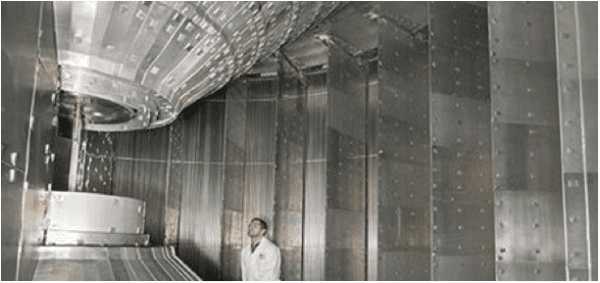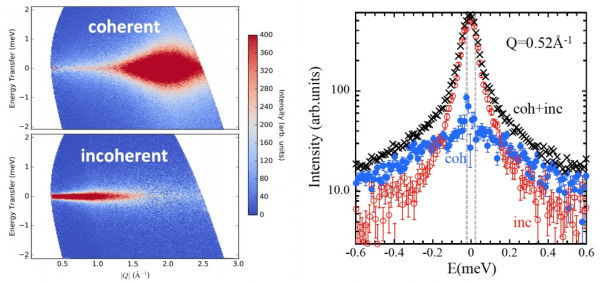Coherent Structural Relaxation of Water from Meso- to Inter-molecular Scales Measured Using Neutron Spectroscopy with Polarization Analysis
Applying recently implemented neutron scattering polarization analysis capabilities at the time-of-flight spectrometer LET (ISIS Neutron and Muon Source, Rutherford Appleton Laboratory, UK), we have been able –for the first time– to separately measure coherent and incoherent dynamic structure factor of heavy water with high resolution and in a wide range of scattering vector. This work opens a new way of approaching the unknown territory of coherent scattering not only in water under different conditions but also in H-bonded liquids and glass-forming systems.
The collective dynamics of water in the terahertz range has been a topic of intense activity since the 1970’s. Most of the work focused on the double peak structure of the inelastic part of the spectrum of density fluctuations –the so-called, at the time, question of `fast’ and `normal’ sound dispersion in water. Although the first investigations applied inelastic neutron scattering, since the 1990’s most studies used inelastic X-ray scattering (IXS). The current consensus rests on a viscoelastic model that assumes the existence of a ‘structural’ relaxation process. A direct observation by IXS of this relaxation is however difficult due to the current resolution of IXS (≤1.5 meV). IXS is also usually limited to mesoscopic scales (scattering vector Q in the range 0.2 ≤ Q ≤ 0.7Å-1). Thus, the crossover towards the inter-molecular scale (Q ≈ 2Å-1 for water) where a ‘deGennes-like’ renormalization is expected for the coherent structural relaxation had not been well explored up to now.

Inside the LET Detector Bank
QENS is the ideal technique with which to directly observe the structural relaxation of water in a wide Q-range and high energy resolution. However, the intensity always contains coherent and incoherent contributions. By means of the recent implementation of neutron polarization analysis (PA) on the wide-angle time-of-flight spectrometer LET (Fig. 1), we have been able for the first time to separately measure coherent and incoherent dynamic structure factor of heavy water with sub-meV resolution in a wide Q range. Our experiment was particularly challenging, because of the weak overall intensity of the signal and the comparable intensities of the coherent and incoherent components at mesoscales. There, LET with PA was able to reveal a striking decoupling of collective and single-particle motions (see Fig. 2) completely hidden in previous experiments. The experimental results were combined with Molecular Dynamics (MD) simulations carried out at the Materials Physics Centre. At mesoscales, the observed decorrelation of the collective fluctuations hardly depends on Q. The directly deduced characteristic time for the structural relaxation there agrees well with that deduced from IXS. In the crossover range towards inter-molecular scales –where the structural relaxation is dominated by diffusion–, the results are nicely described by the convolution of a Q-independent mode and diffusion.

Left: Projections of coherent and incoherent contributions to the neutron intensity scattered by D2O at 295K and separated by PA. Right: Comparison of the coherent and incoherent dynamical structure factors and the total spectrum (coherent + incoherent) at Q=0.52Å-1, i. e., probing the mesoscale region. Vertical dotted lines represent the resolution.
There is no doubt about the paramount importance of water dynamics in many areas of research and industrial applications. Our results constitute the reference for future studies involving water under different conditions or as one of the components. Thus, fields as broad and diverse as biology, soft matter or geology, among others, are highly benefited. In addition, this work illuminates one of the most crucial open questions in the field of liquids and glass-forming systems: to understand the collective dynamics in the region of intermediate length scales or mesoscales, and how it develops toward the intermolecular ones. Finally, this experiment convincingly proves the power of neutron scattering polarization analysis capabilities. This is something extremely important for the whole neutron scattering community. We are confident that it will encourage and stimulate neutron instrument scientists to implement polarization analysis in their spectrometers, as well as users to exploit this novel capability to resolve hidden exciting physics in their neutron experiments.



